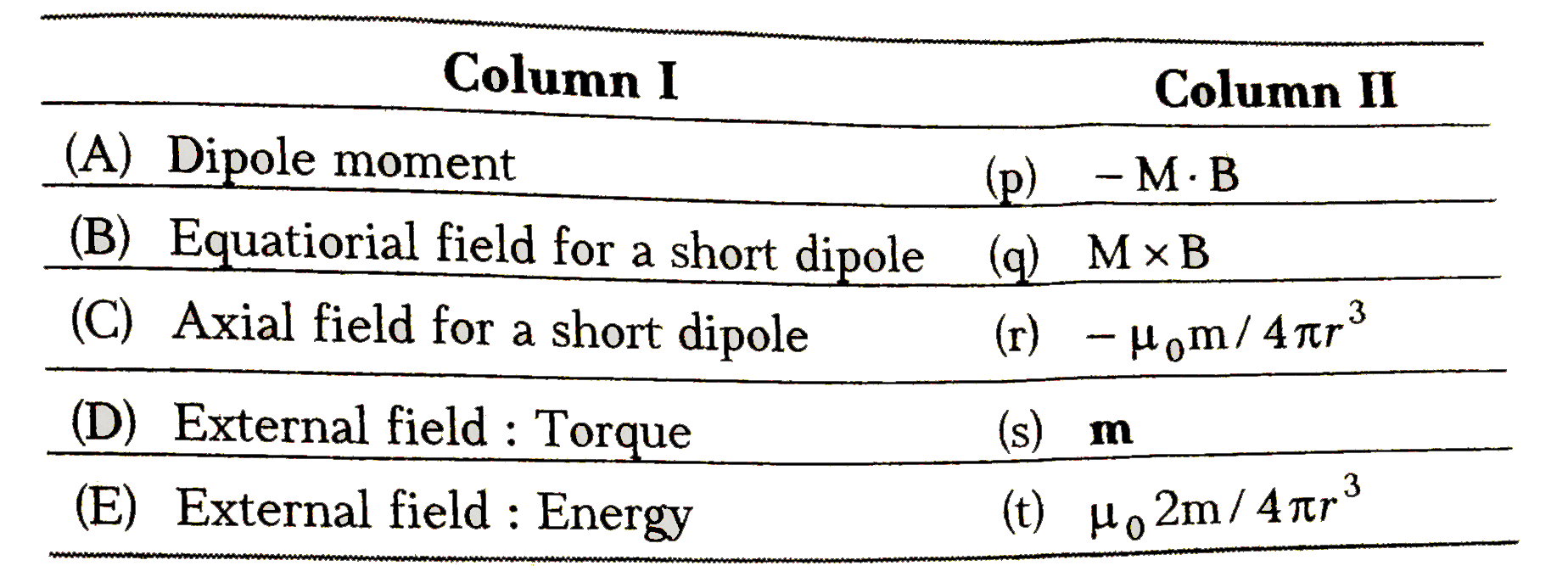Verify the Gauss's law for magnetic field of a point dipole of dipole moment M at the origin for the surface which is a sphere of radius R.
To verify Gauss's law for the magnetic field of a point dipole with dipole moment M at the origin, we will consider a spherical surface of radius R centered at the origin. The steps are as follows:
Step 1: Understand Gauss's Law for Magnetism
Gauss's law for magnetism states that the net magnetic flux through a closed surface is zero:
∮B⋅dS=0
This implies that there are no magnetic monopoles; magnetic field lines are always closed loops.
Step 2: Define the Magnetic Field of a Dipole
The magnetic field B at a point in space due to a magnetic dipole moment M located at the origin can be expressed in spherical coordinates as:
B=μ04π(2Mcosθr3+Msinθr3)
where r is the distance from the dipole, and θ is the angle with respect to the dipole axis.
Step 3: Set Up the Surface Integral
We will calculate the surface integral ∮B⋅dS over a spherical surface of radius R. The differential area element in spherical coordinates is given by:
dS=R2sinθdθdϕ^r
where ^r is the outward normal vector at the surface.
Step 4: Calculate the Magnetic Flux
Substituting B and dS into the integral, we have:
∮B⋅dS=∮(μ04π(2McosθR3+MsinθR3))⋅(R2sinθdθdϕ^r)
This simplifies to:
∮B⋅dS=μ04πR3∮(2Mcosθ+Msinθ)R2sinθdθdϕ
Step 5: Evaluate the Integral
The integral can be separated into two parts:
∮B⋅dS=μ0M4πR3(2∮cosθsinθdθdϕ+∮sinθsinθdθdϕ)
The integral over ϕ from 0 to 2π gives 2π, and the integral over θ from 0 to π can be evaluated as follows:
- The integral ∫π0cosθsinθdθ=0 (because it is symmetric about θ=π2).
- The integral ∫π0sin2θdθ is non-zero but does not contribute to the net flux due to symmetry.
Thus, both integrals yield zero contributions to the total flux:
∮B⋅dS=0
Step 6: Conclusion
Since the total magnetic flux through the spherical surface is zero, we have verified Gauss's law for magnetism:
∮B⋅dS=0
Gauss's law for magnetism states that the net magnetic flux through a closed surface is zero:
∮B⋅dS=0
This implies that there are no magnetic monopoles; magnetic field lines are always closed loops.
The magnetic field B at a point in space due to a magnetic dipole moment M located at the origin can be expressed in spherical coordinates as:
B=μ04π(2Mcosθr3+Msinθr3)
where r is the distance from the dipole, and θ is the angle with respect to the dipole axis.
We will calculate the surface integral ∮B⋅dS over a spherical surface of radius R. The differential area element in spherical coordinates is given by:
dS=R2sinθdθdϕ^r
where ^r is the outward normal vector at the surface.
Substituting B and dS into the integral, we have:
∮B⋅dS=∮(μ04π(2McosθR3+MsinθR3))⋅(R2sinθdθdϕ^r)
This simplifies to:
∮B⋅dS=μ04πR3∮(2Mcosθ+Msinθ)R2sinθdθdϕ
The integral can be separated into two parts:
∮B⋅dS=μ0M4πR3(2∮cosθsinθdθdϕ+∮sinθsinθdθdϕ)
The integral over ϕ from 0 to 2π gives 2π, and the integral over θ from 0 to π can be evaluated as follows:
- The integral ∫π0cosθsinθdθ=0 (because it is symmetric about θ=π2).
- The integral ∫π0sin2θdθ is non-zero but does not contribute to the net flux due to symmetry.
∮B⋅dS=0
Since the total magnetic flux through the spherical surface is zero, we have verified Gauss's law for magnetism:
∮B⋅dS=0
Topper's Solved these Questions
- BOOK - NCERT EXEMPLAR ENGLISHCHAPTER - ELECTROSTATIC POTENTIAL AND CAPACITANCEEXERCISE - Long Answer Type Question10videos
ELECTROSTATIC POTENTIAL AND CAPACITANCE
- BOOK - NCERT EXEMPLAR ENGLISHCHAPTER - MOVING CHARNGES AND MAGNETISMEXERCISE - Long Answer Type Questions7videos
MOVING CHARNGES AND MAGNETISM
Similar Questions
With reference to magnetic dipole, match the tems of Column I with the tems of Column Ii and Choose the correct option from the codes given below.
 View Solution
View SolutionState the ȘI unit of magnetic dipole moment.
View SolutionAn electric dipole has the magnitude of its charge as q and its dipole moment is p. It is placed in a uniform electric field E. If its dipole moment is along the direction of the field, the force on it and its potential energy are respectively
View SolutionThe electric field intensity →E , , due to an electric dipole of dipole moment →p , at a point on the equatorial line is :
View SolutionA magnetic dipole is placed in a uniform magnetic field of intensity B, oriented along the direction of the field. If the magnetic dipole moment is M, then the maximum work an external agent can perform in rotating the dipole will be
View SolutionThe electric field at a point on equatorial of a dipole and direction of the dipole moment
View SolutionFind the magnetic field due to a dipole of magnetic moment 1.2Am2 at a point 1m away from it in a direction making an angle of 60∘ with the dipole-axis.
View SolutionAssertion : A planar circular loop of area A and carrying current I is equivalent to magnetic dipole of dipole moment M = IA.
Reason : At large distances, magnetic field of circular loop and magnetic dipole is same.View SolutionA megnetic dipole with a dipole moment of magnitude 0.020JT is released from rest in a tutiliform magnetic field of magnitude 52mT. The rotation of the dipole due to the magnetic force on it is unimpeded. When the dipole rotates through the orientations where its dipole moment is aligned with the magnetic field, its kinetic energy is 0.80mJ.
(a) What is the initial angle between the dipole moment and the magnetic field?
(b) What is the angle when the dipole is next (momentarily) at rest?View SolutionDerive an expression for the magnetic field at a point on the axis located at a distance x from the centre of a magnetic dipole of length 2l and magnetic moment M.
View Solution

